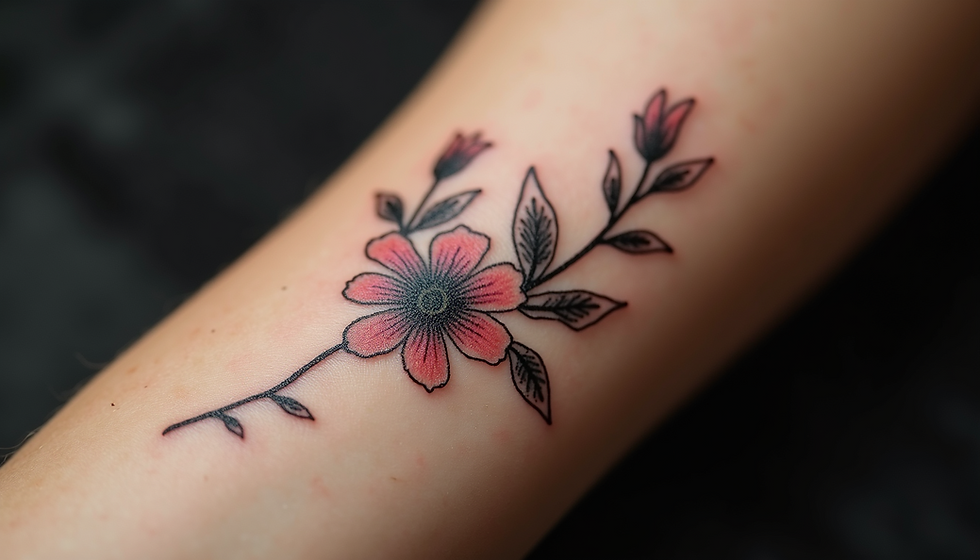Exploring the Art of Fine Line Tattoos
- Micaela Stephens

- Jun 17, 2025
- 4 min read
Updated: Jun 29, 2025
The world of tattoos has evolved dramatically over the years, introducing various techniques and styles that appeal to a wide audience. Among these styles, fine line tattoos have gained significant popularity for their simplicity and elegance. Characterized by thin, delicate lines, this tattoo style often depicts intricate designs that can range from minimalist shapes to detailed illustrations. In this blog post, we will delve into the art of fine line tattoos and explore their beauty, cultural significance, aftercare, and much more.
Delicate Tattoo Designs
Fine line tattoos are particularly known for their delicate tattoo designs. These tattoos can capture intricate details while maintaining a refined aesthetic. Artists use very thin needles to create tattoos with fine lines, allowing them to produce elegant images that flow seamlessly. Popular subjects include nature motifs, like flowers and leaves, as well as celestial themes, such as stars and moons.

Many people are drawn to fine line tattoos for their versatility. You can customize these tattoos to convey personal messages, sentiments, or stories. For example, a small fine line heart can symbolize love while an abstract design can represent one’s journey or aspirations. The minimalistic approach allows for subtle expression without overwhelming visuals.
The Rise of Fine Line Tattoos
In recent years, fine line tattoos have surged in popularity, especially among younger generations. According to a report by Grand View Research, the global tattoo market is expected to reach USD 50 billion by 2025, with fine line tattoos capturing significant market share. This trend can be attributed to various factors, including social media’s role in showcasing tattoo culture.
Platforms like Instagram and Pinterest have made it easier for tattoo artists to share their work. The delicate nature of fine line tattoos photographs beautifully, attracting likes and shares. This visibility has motivated many individuals to seek out this precise art form, further fueling its rise.
Cultural Significance
Tattoos have long been a form of self-expression across various cultures. Fine line tattoos are no exception, often carrying deep personal meanings. For instance, a feather can represent freedom, while geometric shapes may reflect one’s connection to nature. Some fine line tattoos even celebrate spiritual beliefs or commemorate loved ones.
In different cultures, tattoos serve as rites of passage or symbols of maturity. In Maori culture, tattooing is called "ta moko" and holds significant importance in identity and status. Similarly, in various indigenous groups around the world, tattoos tell stories of ancestry and heritage. Fine line tattoos can take on these cultural elements, allowing individuals to express their backgrounds through delicate designs.

Choosing the Right Design
Selecting the right fine line tattoo design can feel overwhelming, but it can also be an exciting process. Here are some helpful tips to guide you:
Reflect on Personal Meaning: Consider designs that resonate with your experiences or values. A tattoo that holds personal significance will likely be more fulfilling.
Draw Inspiration: Use platforms like Instagram or Pinterest to explore fine line tattoo designs. Save the ones you love to a mood board for later consideration.
Consult a Professional Artist: It's essential to work with a talented tattoo artist specialized in fine line tattoos. Discuss your ideas and seek their advice on ensuring the design complements your body and aligns with your vision.
Start Small: Especially for your first tattoo, consider opting for a smaller design. This approach not only eases the experience but also gives you a chance to see how your skin reacts to ink before committing to larger pieces.
Visualize the Placement: Think carefully about where you want the tattoo. The placement can impact how the design is perceived. For instance, a tattoo on the wrist will be more visible than one on the ankle.
Tattoo Aftercare
Once you have your fine line tattoo, proper aftercare is crucial to ensure it heals beautifully. Here are some essential aftercare tips:
Keep it Clean: After getting your tattoo, wash the area gently with mild, unscented soap and pat it dry with a clean towel.
Moisturize: Apply a thin layer of fragrance-free lotion or a special tattoo aftercare ointment to keep the skin hydrated. Don’t overdo it; a small amount will suffice.
Avoid Sun Exposure: For the first few weeks, keep your tattoo out of direct sunlight. UV rays can fade delicate ink, so consider wearing clothing that covers the area or applying sunscreen once the tattoo has healed.
Avoid Swimming: Stay away from bodies of water, including pools and beaches, for at least two weeks post-tattoo. Immersion can introduce bacteria and hinder the healing process.
Don’t Scratch or Pick: As your tattoo heals, it may itch or scab. Avoid scratching or picking at the tattoo, as this can result in scarring and affect the final appearance.
Final Thoughts on Fine Line Tattoo Artistry
Fine line tattoos offer individuals an opportunity to express their identity and artistry in a subtle yet striking way. With their delicate designs and significance, these tattoos continue to captivate people worldwide. By understanding the art of fine line tattooing, considering design choices, and committing to proper aftercare, you can enjoy a lasting piece of personal expression.
If you are ready to take the plunge into the world of fine line tattoos, visit Stigma Ink Tattoo for inspiration and professional consultation. Discover a unique design that reflects your personality and remember the power of the stories behind each inked line. Happy tattooing!











Comments